When we talk about smart cities, we often think of sensors, data, and futuristic dashboards. But the real transformation is happening with tools as simple as QR codes. In smart cities around the world, these pixelated squares are becoming an invisible layer of connectivity—linking citizens to public services, events, emergency info, and more with a simple scan.
Why QR codes in smart cities are gaining momentum
City planners and officials are under pressure to make urban areas more efficient, inclusive, and user-friendly. And while many technologies require heavy infrastructure or long implementation cycles, QR code technology offers something rare: instant utility.
Dynamic QR codes, in particular, allow real-time updates and redirect users to live information—without the need to reprint signs or stickers. From waste disposal instructions to bus stop wait times, one scan can open up real-time data streams tailored to location, service, or even individual preferences.
How cities are using QR codes to connect physical and digital worlds
Across public spaces—think parks, train stations, libraries, or hospitals—QR codes offer instant access to information or action.
- At a bus stop, a scan provides real-time arrival estimates, alternate routes, or service alerts.
- In museums or cultural centers, QR codes unlock audio guides, AR layers, or educational content.
- In emergencies, they offer contact details, safety instructions, or direct links to report issues.
The beauty lies in how they tie together the physical and digital worlds: no app downloads, no passwords, just immediate access via mobile devices already in every pocket.
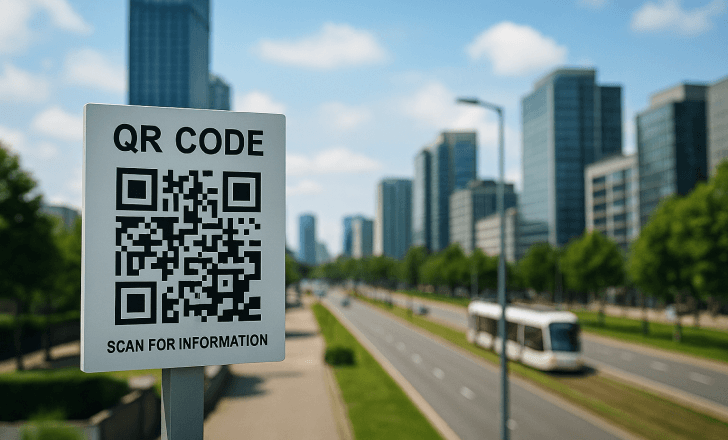
Making urban infrastructure more user-friendly
Smart infrastructure isn’t only about sensors and big data. It’s also about designing for the general public—creating smarter, more human-centered systems. QR codes help make public services more accessible, especially for tourists, new residents, or anyone facing language barriers.
A dynamic QR code on a parking meter can explain how to pay, offer contactless payments, and even push real-time rate changes during peak hours. Embedding QR codes on recycling bins can guide users on proper sorting, improving waste management systems at the source.
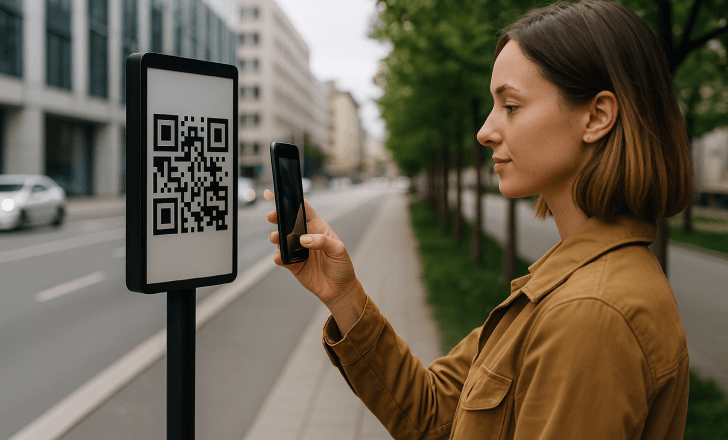
A cost-effective way to enhance city services
Many cities face budget constraints, especially when upgrading legacy systems. Integrating QR codes is an affordable way to modernize services without overhauling entire platforms.
Cities can add QR codes to existing signage, vehicles, kiosks, or printed materials. When scanned, they can lead to anything: a landing page for reporting potholes, a video explaining new traffic rules, or a multilingual welcome guide for visitors. All without altering the physical landscape.

Engaging residents through real-time information and services
One of the greatest strengths of QR codes is their flexibility. City officials can update linked content in seconds—whether it’s real-time updates during a heatwave or last-minute changes to a local festival schedule.
This real-time flexibility creates interactive experiences. Residents can check public event details, explore park maps, or even rate public services after use. For cities aiming to boost citizen engagement, this kind of direct, low-barrier interaction is invaluable.
Making public transportation smarter with QR codes
Public transportation is a clear win for QR integration. Instead of static maps or printed schedules that quickly become outdated, QR codes give riders easy access to the latest updates.
- Scan a code to get the next train’s arrival time.
- Link to a map showing the closest bike share station.
- Provide visitors with instant access to fare calculators, mobile ticketing, or accessibility info.
This isn’t just about convenience—it’s about empowering users with timely, location-specific knowledge.
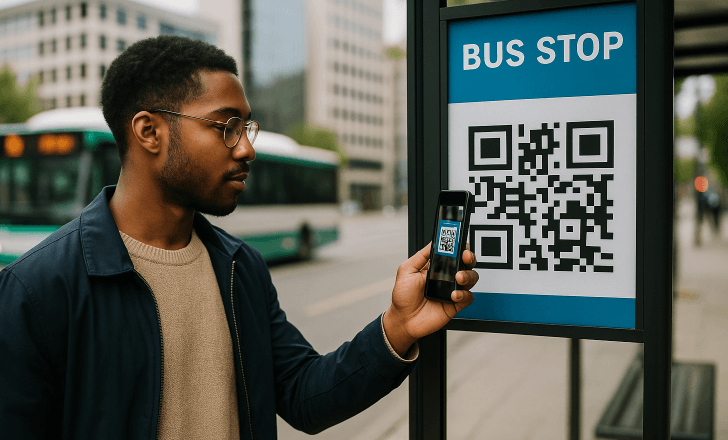
Supporting sustainability and better resource management
QR codes in smart cities also play a role in promoting greener habits. Instead of printing flyers or signs for every announcement, one QR code can replace dozens of static materials.
More than that, QR codes help manage energy consumption by optimizing how and when information is delivered. A code can lead to a tool that helps residents calculate their household’s energy use, or offer advice on more sustainable commuting options. Over time, small nudges like these can shift behaviors at scale.
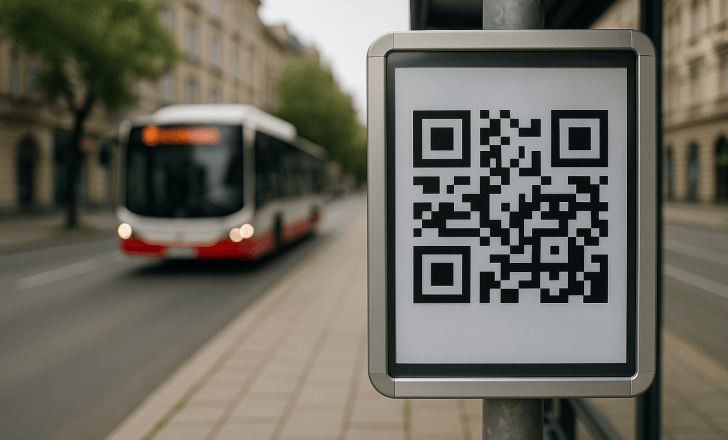
Giving tourists and visitors a better experience
When navigating unfamiliar urban areas, tourists often rely on search engines or maps—but these can be unreliable or overwhelming. By placing QR codes throughout key locations, cities can provide visitors with curated, context-aware guides.
- A QR at a train station might offer directions in multiple languages.
- A sticker near a monument could launch a mini-history lesson or interactive experience.
- Codes placed near local businesses might unlock time-limited offers or event details.
This approach helps cities become more welcoming, while also supporting local economies.

Are QR codes replacing other smart city tech?
Not quite. QR codes don’t compete with near field communication (NFC) or sensor-driven systems—they complement them. Where NFC might require newer phones or physical proximity, QR codes are universal, visual, and easily accessible to anyone with a camera-equipped phone.
They’re also more transparent. When you scan a QR code, you see where you’re going. There’s no mystery, no background data collection—just a direct line to information or services. That trust is important in today’s privacy-conscious world.
How can cities ensure adoption across all demographics?
Adoption depends on smart design and communication. QR codes should be:
- Placed in visible, intuitive locations.
- Linked to content that’s user friendly and useful.
- Tested across devices to ensure reliable scanning.
Education helps too. Cities can run small campaigns showing how QR codes work and what services they connect to. Even one positive experience—like scanning a QR code at a festival to get the lineup—can turn a skeptic into a regular user.

What role do QR codes play in emergency services?
In emergencies, QR codes offer a fast, silent way to share or receive critical info. They can:
- Direct users to evacuation routes.
- Provide emergency contact numbers.
- Help report issues directly to municipal teams.
- Offer health guidance, shelter locations, or real-time updates during crises.
By decentralizing access to vital data, QR codes support emergency services without overwhelming call centers or requiring on-site personnel.
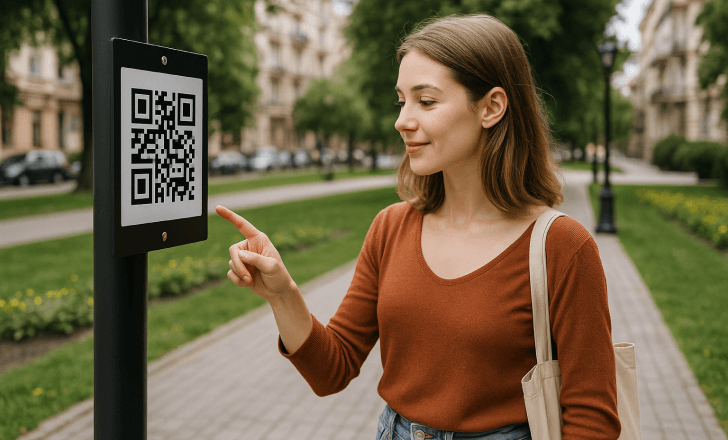
How can QR codes improve waste management?
Waste management in cities is often fragmented and misunderstood. Incorporating QR codes into bins, trucks, or community notices can help:
- Educate on proper sorting and disposal.
- Push updates on collection schedules.
- Offer incentives for recycling or composting participation.
This real-time, location-based approach makes recycling simpler and more effective—especially when urban planning teams use the data to adapt services.

What’s next for QR codes in smart cities?
The future is already unfolding. As cities grow more connected, expect to see QR codes integrated into:
- Smart home platforms for municipal alerts.
- Wearables or ID cards that link to personalized city dashboards.
- Public screens or kiosks where a simple scan can guide next steps.
But more importantly, we’ll see QR codes not just as tech gimmicks, but as a crucial tool for connecting people to place—one scan at a time.

